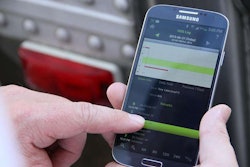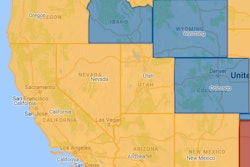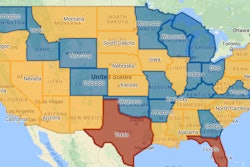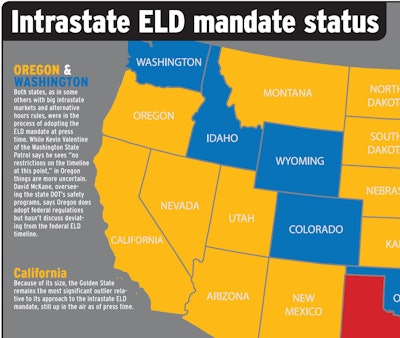

No small amount of road rumor has swirled around the trucking community about just what states might do relative to the electronic logging device mandate for the subset of truckers operating entirely within a state’s borders and keeping log books. If a state’s intrastate hours of service regulations differ at all from the federal interstate rule, they tend to be less restrictive. They often allow more on-duty time, more drive time and higher cumulative limits.
Joe Rajkovacz of the Western States Trucking Association says that until recently, the big question was: “Do states, for their intrastate markets, thumb their noses” at the federal mandate? Rajkovacz is based in California, which, with Texas, represents one of the nation’s two largest intrastate markets in the lower 48.
Texas seemed to answer that question this year with additions to its regulatory code governing intrastate operations, making news in April. It adopted the federal mandate by reference to it, thus requiring implementation of ELDs for intrastate carriers. However, there was one significant revision: Given the size of Texas’ intrastate market, officials decided to delay the implementation timeline.
“If you’re a carrier in a small state,” says Texas Department of Public Safety Maj. Jeremy Nordloh, “you’re probably always under interstate rules. But you can have a significant intrastate operation in Texas.”
Adding further fuel to intrastate-related road rumors is the additional complexity of a local hauling exemption from the federal ELD mandate. Operators always running under the short-haul (100- or 150-air-mile radius) exemptions to the hours of service do not need to use an ELD. But if they do occasionally run outside the radius, they can avoid using an ELD as long as they keep a log book for no more than eight days in any 30-day period. For intrastate mandates, the exemptions for pre-2000 model-year trucks and driveaway operations also will apply.
Apart from state or federal ELD mandates, intrastate hours of service regulations in Texas are different than the federal rule most Overdrive readers operate under. For example, Texas allows 12 hours of driving in a 15-hour window, with a 70 hours in seven days cumulative on-duty limit. Hours regulations also differ in other states with significant intrastate markets, such as California, Alaska and Florida.
Which hours of service rule do you typically operate under?
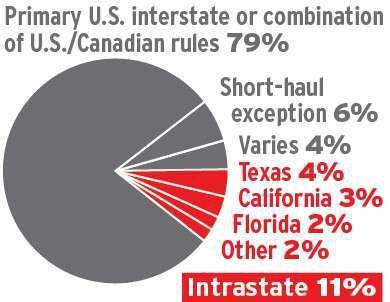 Approximately one in every nine Overdrive readers operates exclusively under one of the different intrastate hours of service rules. The large majority of those in-state haulers are in Texas, California and Florida. Those states allow for more drive time (12 hours) and on-duty time (15 or 16 hours) in their daily limits. Their cumulative limits are higher for in-state haulers, too, though states treat those limits slightly differently.
Approximately one in every nine Overdrive readers operates exclusively under one of the different intrastate hours of service rules. The large majority of those in-state haulers are in Texas, California and Florida. Those states allow for more drive time (12 hours) and on-duty time (15 or 16 hours) in their daily limits. Their cumulative limits are higher for in-state haulers, too, though states treat those limits slightly differently.Many ELD providers’ products support a variety of intrastate rules, delivering hours-limit warnings to drivers and carrier staff operating under a specific rule. However, many new providers entered the market following the federal mandate. Most of their products offer compliance warnings, time counters and such, but not all have options for particular intrastate rules.
Texas’ relaxed timeline for intrastate haulers requires ELD use on Dec. 19, 2019, two years beyond the December 2017 deadline for interstate truckers. Chief in calculating that delay, Nordloh says, is a concern over having enough providers to support Texas’ intrastate rules. “We gave it a blanket deadline in December 2019 to give as much benefit to the intrastate carriers as we could,” he says.
With that date, Texas has pushed adoption and enforcement of the ELD rule a bit further than is technically allowed by federal regulation, meaning there could be some risk to federal funding of safety and enforcement programs. Guidance in Title 49, Part 355, of the Code of Federal Regulations requires states to “adopt and enforce” federal regulations pertaining to intrastate commercial vehicle operations within three years of the effective date of the federal regulation. Since the effective date for the ELD rule was February 16, 2016, the three years would be up in February 2019, 10 months before the state’s deadline for compliance with its intrastate rule.
Federal officials did not respond to an inquiry about Texas’ compliance with that guidance.
Many states responding to Overdrive queries noted they already had adopted the ELD regulation and were sticking to the federal timeline for the intrastate haulers under the hours of service in their states. However, most of these states use hours limitations for intrastate hauling, with some exceptions, that are identical to the federal rules.
Not all exception states are pushing against the three-year regulatory adoption requirement as aggressively as Texas. At press time, Florida’s legislature was adopting federal regulations and specified a Dec. 31, 2018 date for ELD implementation for carriers operating under its daily limits of 12-hour-drive/16-on-duty, or cumulative 70 hours in seven days or 80 in eight.
“This gives the intrastate industry time to come into compliance after our legislation passes,” says Major Derek Barrs of the Florida Highway Patrol’s commercial vehicle enforcement office. He notes this is similar to what was “done for interstate carriers after the rule went into effect” in early 2016, with interstate enforcement following near the end of this year, Barrs says.
California might be the most significant remaining intrastate outlier, given the size of its market. Jill Schultz, hours regulations expert for J.J. Keller & Associates, suspects that, unlike Florida’s legislative and Texas’ quick adoption-by-reference methods, the Golden State likely will go through a regulatory action. “California has not put a proposal out yet,” Schultz says.
Officials with the California Highway Patrol declined to comment on a timeline. Fran Clader in CHP’s communications office says the agency is developing “regulations for ELDs, including applicability to intrastate drivers/carriers.”
Next in this series: Is it necessary for an ELD to ‘support’ intrastate hours rules?


